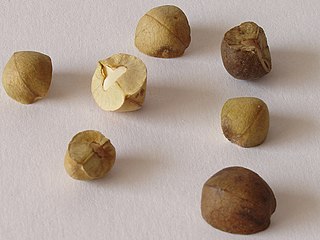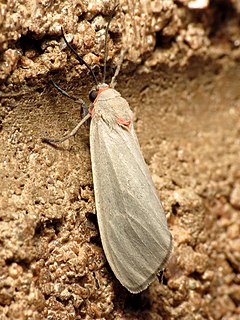
Yucca is a genus of perennial shrubs and trees in the family Asparagaceae, subfamily Agavoideae. Its 40–50 species are notable for their rosettes of evergreen, tough, sword-shaped leaves and large terminal panicles of white or whitish flowers. They are native to the hot and dry (arid) parts of the Americas and the Caribbean.

The Tortricidae are a family of moths, commonly known as tortrix moths or leafroller moths, in the order Lepidoptera. This large family has over 11,000 species described, and is the sole member of the superfamily Tortricoidea, although the genus Heliocosma is sometimes placed within this superfamily. Many of these are economically important pests. Olethreutidae is a junior synonym. The typical resting posture is with the wings folded back, producing a rather rounded profile.

Mexican jumping beans are seed pods that have been inhabited by the larva of a small moth and are native to Mexico. The "bean" is usually tan to brown. They are from the shrub Sebastiania pavoniana, often also referred to as "jumping bean". However, they are not related to actual beans, but rather to spurges. The beans are considered non-toxic but are not generally eaten. In the spring, when the shrub is flowering, moths lay their eggs on the shrub’s hanging seedpods. When the eggs hatch, tiny larvae bore into the immature green pods and begin to devour the seeds. The pods ripen, fall to the ground and separate into three smaller segments, and those segments are called Mexican jumping beans. As the tiny larvae inside curl up and uncurl, they hit the capsule’s wall with their heads – and the bean jumps. It’s been observed that they move more as temperatures rise, the larva eats away the inside of the bean and attaches itself to the inside of the bean with silk-like thread. The larva may live for months inside the bean with varying periods of dormancy. If the larva has adequate conditions of moisture and temperature, it will live long enough to go into a pupal stage. In the spring, the moth forces itself out of the bean through a round "trap door", leaving behind the pupal casing. After its metamorphosis, the small, silver and gray-colored moth lives for no more than a few days.

The erebid moth Ascalapha odorata, commonly known as the black witch, is a large bat-shaped, dark-colored nocturnal moth, normally ranging from the southern United States to Brazil. Ascalapha odorata is also migratory into Canada and most states of United States. It is the largest noctuoid in the continental United States. In the folklore of many Central American cultures, it is associated with death or misfortune.

Pygarctia is a genus of moths in the family Erebidae.
Pygarctia spraguei, also known as Sprague's pygarctia or Sprague's tiger moth, is a moth of the family Erebidae. It was described by Augustus Radcliffe Grote in 1875. It is found in North America from the Great Plains of southern Canada to Texas, westward to Utah, eastward to Indiana and Louisiana.
Pygarctia abdominalis, the yellow-edged pygarctia or orange-bodied pygarctia, is a moth in the family Erebidae. It was described by Augustus Radcliffe Grote in 1871. It is found in the United States from New Jersey south to Florida and west to Texas.
Pygarctia angelus is a moth in the family Erebidae. It was described by Harrison Gray Dyar Jr. in 1907. It is found in Mexico.
Pygarctia eglenensis, the gray-winged pareuchaetes, is a moth in the family Erebidae. It was described by James Brackenridge Clemens in 1861. It is found in the US states of Texas and Florida.
Pygarctia flavidorsalis is a moth in the family Erebidae. It was described by William Barnes and James Halliday McDunnough in 1913. It is found in the US states of Arizona and Texas. There is also a record for Oklahoma.
Pygarctia haematodes is a moth in the family Erebidae. It was described by Harrison Gray Dyar Jr. in 1921. It is found in Mexico.
Pygarctia lorula is a moth in the family Erebidae. It was described by Harrison Gray Dyar Jr. in 1914. It is found in the US state of New Mexico.
Pygarctia matudai is a species of moth in the family Erebidae. It was described by Carlos Rommel Beutelspacher in 1978. It is found in Mexico.

Pygarctia murina, the mouse-colored euchaetias, is a moth in the family Erebidae. It was described by Richard Harper Stretch in 1885. It is found in the United States in south-western Utah, from southern Colorado to south-eastern California and in southern Texas.
Pygarctia neomexicana is a moth in the family Erebidae. It was described by William Barnes in 1904. It is found in the US states of Texas, Arizona, Colorado, New Mexico and Utah.

Pygarctia roseicapitis, the red-headed pygarctia moth, is a moth in the family Erebidae. It was described by Berthold Neumoegen and Harrison Gray Dyar Jr. in 1893. It is found in Mexico and in the United States from southern Arizona to Texas.

A MONA number, or Hodges number after Ronald W. Hodges, is part of a numbering system for North American moths found north of Mexico in the Continental United States and Canada, as well as the island of Greenland. Introduced in 1983 by Hodges through the publication of Check List of the Lepidoptera of America North of Mexico, the system began an ongoing numeration process in order to compile a list of the over 12,000 moths of North America north of Mexico. The system numbers moths within the same family close together for identification purposes. For example, the species Epimartyria auricrinella begins the numbering system at 0001 while Epimartyria pardella is numbered 0002.







